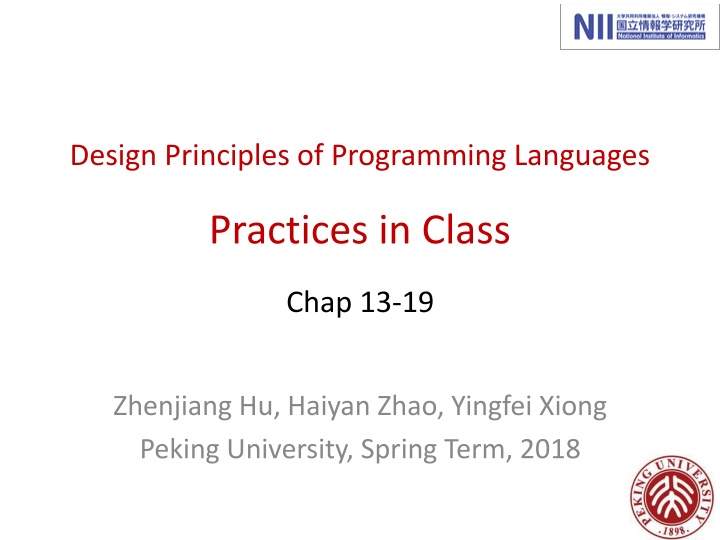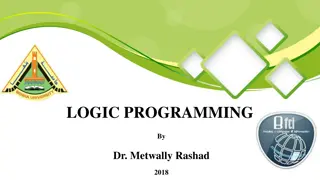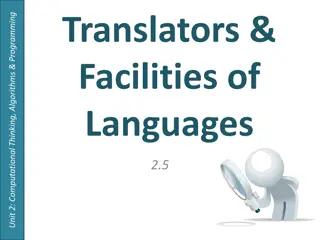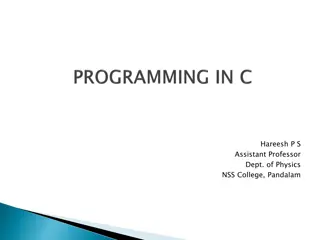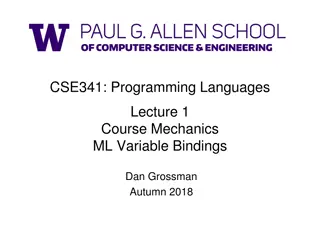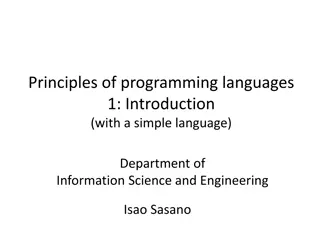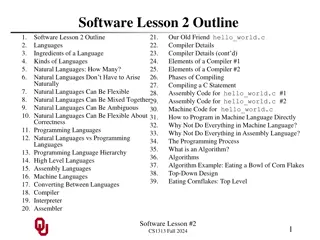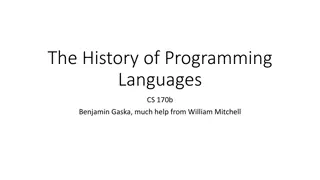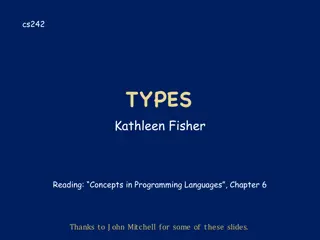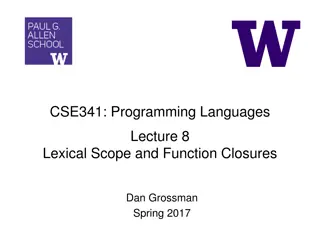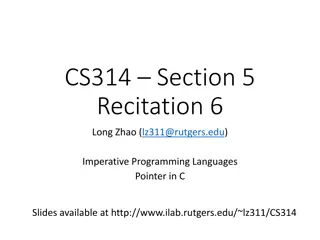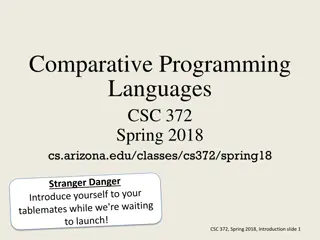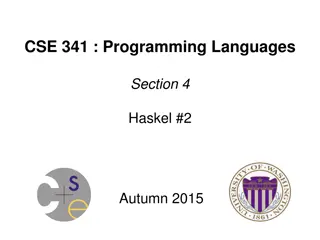Design Principles of Programming Languages Practices
Programming language design principles and practices in a class setting at Peking University. Topics include syntax, evaluation, typing, subtype relation, records, algorithmic subtyping, and more. Dive into the realm of algorithmic typing and subtyping algorithms for enhanced understanding of programming language concepts.
Download Presentation

Please find below an Image/Link to download the presentation.
The content on the website is provided AS IS for your information and personal use only. It may not be sold, licensed, or shared on other websites without obtaining consent from the author.If you encounter any issues during the download, it is possible that the publisher has removed the file from their server.
You are allowed to download the files provided on this website for personal or commercial use, subject to the condition that they are used lawfully. All files are the property of their respective owners.
The content on the website is provided AS IS for your information and personal use only. It may not be sold, licensed, or shared on other websites without obtaining consent from the author.
E N D
Presentation Transcript
Design Principles of Programming Languages Practices in Class Chap 13-19 Zhenjiang Hu, Haiyan Zhao, Yingfei Xiong Peking University, Spring Term, 2018
Code packages fullref fullerror rcdsub fullsub joinsub joinexercise
Syntax We added to (with Unit) syntactic forms for creating, dereferencing, and assigning reference cells, plus a new type constructor Ref.
Evaluation Evaluation becomes a three-place relation: t | t |
Typing Typing becomes a four-place relation: | t T
Subtyping Algorithm This recursively defined total function is a decision procedure for the subtype relation: subtype(S, T) = if T = Top, then true else if S = S1 S2and T = T1 T2 then ??????? T1,S1 ???????(S2,T2) else if S = {kj: Sj then {li for all ? 1..? there is some ? 1..? with kj= li and ???????(Sj,Ti) else false. j 1..m} and T = {li: Tii 1..?} i 1..n} {kj j 1..m}
Algorithmic Typing The next step is to build in the use of subsumption in application rules, by changing the T-App rule to incorporate a subtyping premise. Given any typing derivation, we can now 1. normalize it, to move all uses of subsumption to either just before applications (in the right-hand premise) or at the very end 2. replace uses of T-App with T-SUB in the right-hand premise by uses of the extended rule above This yields a derivation in which there is just one use of subsumption, at the very end!
Practice #1 Do exercise 17.3.1 The joinexercise typechecker is an incomplete implementation of the simply typed lambda-calculus with subtyping, records, and conditionals: basic parsing and printing functions are provided, but the clause for TmIf is missing from the typeof function, as is the join function on which it depends. Add booleans and conditionals (and joins and meets) to this implementation. Refer to: 16.3 showed how adding booleans and conditionals to a language with subtyping required extra support functions for calculating the least upper bounds of a given pair of types. The proof of Proposition 16.3.2 (see page 522) gave mathematical descriptions of the necessary algorithms 12
Practice #2 Do exercise 17.3.3 the subtype check in the application rule fails, the error message that our typechecker prints may not be very helpful to the user. We can improve it by including the expected parameter type and the actual argument type in the error message. Error reporting can be greatly improved by changing the subtype function so that, instead of returning true or false, it either returns a trivial value (the unit value ()) or else raises an exception. Reimplement the typeof and subtype functions to make all of the error messages as informative as possible.
Design Principles of Programming Languages Practices Chap 18-19 Please refer to the package of fullref Zhenjiang Hu, Haiyan Zhao, Yingfei Xiong Peking University, Spring Term, 2019
What learnt in Chap 18-19 1. Identify some characteristic core features of object- oriented programming 2. Develop two different analysis of these features: 2.1 A translation into a lower-level language 2.2 A direct, high-level formalization of a simple object- oriented language ( Featherweight Java )
Object-oriented languages In most OO languages, each object is regarded as A data structure encapsulating some internal state offering access to this state via a collection of methods. basic features of object-oriented languages encapsulation Inheritance .
Modeling features of OO with -calculus How the basic features of object-oriented languages encapsulation of state Inheritance can be understood as derived forms in a lower-level language with a rich collection of primitive features: (higher-order) functions records references recursion subtyping
Encapsulation An object is a record of functions, which maintain common internal state via a shared reference to a record of mutable instance variables. This state is inaccessible outside of the object because there is no way to name it. lexical scoping ensures that instance variables can only be named from inside the methods.
Inheritance Objects that share parts of their interfaces will typically (though not always) share parts of their behaviors. To avoid duplication of code, implementations of these behaviors in just one place. inheritance the way is to write the Basic mechanism of inheritance: classes A class is a data structure that can be instantiated to create new objects ( instances ) refined to create new classes ( subclasses )
The essence of objects Encapsulation of state with behavior Behavior-based subtyping Inheritance (incremental definition of behaviors) Access of super class Open recursion through this
Featherweight Java A concrete language with core OO features FJ Models core OO features and their types and nothing else. History: Originally proposed by a Penn visiting student (Atsushi Igarashi) as a tool for analyzing GJ ( Java plus generics ), which later became Java 1.5 Since then used by many others for studying a wide variety of Java features and proposed extensions
Things left in FJ Classes and objects Methods and method invocation Fields and field access Inheritance (including open recursion through this) Casting
Things left out of FJ Reflection, concurrency, class loading, inner classes, ... Exceptions, loops, ... Interfaces, overloading, ... Assignment (!!)
Practice #1 Do exercise 18.6.1 Write a subclass of resetCounterClass with an additional method dec that subtracts one from the current value stored in the counter Use the fullref checker to test your new class 26
Practice #2 Do exercise 18.7.1 Define a subclass of backupCounterClass with two new methods, reset2 and backup2, controlling a second backup register. This register should be completely separate from the one added by backupCounterClass: calling reset should restore the counter to its value at the time of the last call to backup (as it does now) and calling reset2 should restore the counter to its value at the time of the last call to backup2. Use the fullref checker to test your new class 27
Practice # 3 Do exercise 19.4.3 The operation of assigning a new value to the field of an object is omitted from FJ to simplify its presentation, but it can be added without changing the basic character of the calculus very much. Using the treatment of references in Chapter 13 as a model. 28
Practice #4: Challenge Do exercise 19.5.5 Starting from one of the lambda-calculus typecheckers, build a typechecker and interpreter for Featherweight Java. Submit your typechecker and interpreter before June 3 29
